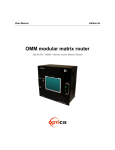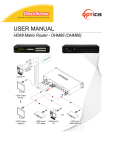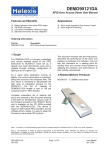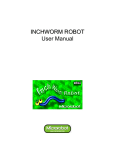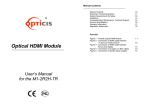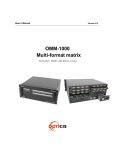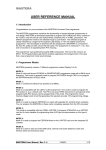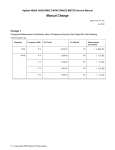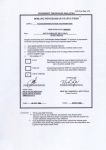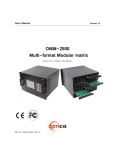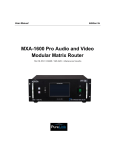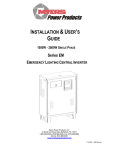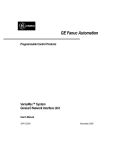Download USER MANUAL
Transcript
Edition 2a ODM1818 18:18 DVI Matrix Routers USER MANUAL 1/59 TABLE OF CONTENTS CHAPTER 1. INTRODUCTION AND INSTALLATION 1.1 Notice for safe usage 1.2 Physical Description 1.3 EDID Control and Configuration CHAPTER 2. COMMUNICATIONS SETUP 2.1 Setting Router ID of ODM1818 2.2 Front Panel control 2.2.1 CREATE Mode 2.2.2 PREVIEW Mode 2.2.3 CANCEL Mode 2.2.4 FUNCTION Mode 2.3 Serial Communication 2.4 Ethernet Control 2.5 USB Control CHAPTER 3. OPERATIONS 3.1 Front Panel Operation 3.2 Command Line Operation 3.3 Web Control Panel Operation 3.4 Proprietary PC Software Operation 3.4.1 Installation of PC Program Application 3.4.2 Installation of USB Driver 3.4.3 Operation by PC Program Appendix A. Trouble shooting B. Feature C. Specification D. Firmware downloading 2/59 3/59 CHAPTER 1. INTRODUCTION AND INSTALLATION The ODM1818, 18X18 DVI Matrix Router is a high speed cross switcher of 18 DVI inputs and 18 DVI outputs. Having a ruggedized metallic enclosure, the ODM1818 gives applicability to harsh environments. The key features are; Eighteen (18) DVI single-link inputs and output Up to WUXGA (1,900x1,200) pixel resolution at 60Hz refresh ratio, having 1.65Gbps transmission bandwidth EDID management – flexible adaptation to power management of overall systems Direct readout from connected displays Preset to input ports Long distance extension of DVI input and output by Optical DVI cables or modules Reclocking of R,G,B of DVI inputs and outputs Various Control Interfaces; Front panel key input Commands input through RS232, LAN, and USB Graphic user interface over Ethernet Graphic user interface using Proprietary PC software in the shipping group Hierarchical connection of multiple ODM1818 up to 3 levels to widen the number of display connection or source connection DIP switch setting for differentiating multiple use of DS-1818M II over RS232 connection IP setting for Ethernet – point-to-point and local network control 4/59 The shipping group consists of the followings; Hard plastic case to carry: 1 set Mainframe of ODM1818: 1 set AC/DC power adaptor (12V/10A, AC110V-240V): 1 set AC power cord: 1 set User Manual: 1 set CD storing PC control software: 1 set A plug – B plug USB cable: 0.5m Firmware download cable: 1 set RS-232 cable: 1set 1.1 Notices for Safe Usage If the equipment is used in a manner not specified by the manufacture, it might be impaired in inability of recovery. Use the assigned power cord or power adaptor in the shipping group. Connect the power cord to the normal and safe outlet. Keep the unit away from the liquid, magnetic and combustible substances. Do not place heavy weights on the unit. Move away from noisy environments like vibration or impact. Do not install the unit vertically. Do not disassemble the unit by user’s own discretion. When any malfunction or breakdown occurs, contact us promptly. 5/59 1.2 Physical Description The ODM1818 is mountable on 19” standard rack with brockets. On front panel are some function keys, input-output buttons and a status display window placed as shown in Figure 1-1. CONTROL keys: ① Create - Start updating or configuring input-output setup Preview - Show current status of input-output configuration Cancel – Destruct all outputs configured with a input or Reject any key inputs Enter - Accept key inputs and complete configuring input-output setup Function - Configure IP for Ethernet, set baud rate for RS232 and set EDID: Input-output Buttons: Eighteen (18) illuminated LED type buttons for input: ② Eighteen (18)) illuminated LED type buttons for output: ③ Status window display - display the control status in 20x4 text mode: ④ Power ON/OFF button: ⑤ Reset button – Restart: Push with a needle pen ⑥ Figure 1-1 Front Panel of ODM1818 6/59 All input, output, interface and power connections are placed on the rear panel and are featured as follows; Eighteen (18) single link DVI inputs - female type: ① Eighteen (18) single link DVI outputs - female type: ② DIP switch - 8 bits to set identifier in case of multiple connection of ODM1818: ③ USB B type receptacle port: ④ RS 232 Serial port - selectable of baud rates: ⑤ 10/100 Base Ethernet Port: ⑥ Download Port - firmware download: ⑦ DC power receptacle: ⑧ Figure 1-2 Rear Panel of ODM1818 7/59 1.3 EDID Control and Configuration EDID (Extended Display Identification Data) is a data structure provided by a display to describe its capabilities to a graphic card. It is what enables a PC to know what kind of monitor is connected. It includes manufacturer name, product type, phosphor or filter type, timings supported by the display, display size, luminance data and (for digital displays only) pixel mapping data. Once the graphic source reads it out (usually done in booting PC), the EDID helps it know information of best-fit data format for a connected monitor. Besides of configuration of inputs and outputs, the ODM1818 supports EDID configuration to store any wanted EDIDs to an EEPROM of each input by front key control, command codes and web control panel setting. The ODM1818 gives two choices for EDID setting out of fixed factory EDID and direct readout-store EDID of any targeted display. The factory default setting is UXGA (1,600x1,200) at 60Hz for all inputs. INPUT 1~18 OUTPUT 1~18 WRITE EDID EEPROM1 EEPROM2 EEPROM3 . . . . EDID INTERFACE CONTROL . . . . EEPROM16 EEPROM17 EEPROM18 Figure 1-3 Concept drawing of EDID setting and working in ODM1818 8/59 As shown in the concept drawing, once you do EDID configuration, then each EDID is stored in EEPROM at the front of DVI input and the video sources could read out each EDID in the EEPROM. The beauty of working is that the video sources enable to start reading EDID in boot-up even though the ODM1818 and connected displays are not powered on yet. Connection of Optical DVI cables and modules for long distance extension The ODM1818 supports connection of Optical DVI cables or modules to the inputs and outputs. We strongly recommend not using copper DVI cables over 3 m (10ft) extension, but using fiber-optic DVI products. Initializing ODM1818 and Installation Guide INITIALIZATION Plug a adequate AC power cord in the shipping group to the AC/DC power adaptor and plug the DC cord to the +12VDC connector on the rear panel while caring the arrow mark on the connector of the DC cord. Push POWER button on the front panel then you could see; Red LED lit on the button and Initializing … 18X18 DVI Matrix on the display window and sweeping Green and Red lights on the Input and Output buttons respectively. Finally shows USER MODE on the display window, which means being ready to accept commands. RACK MOUNTING Before installing cables, the ODM1818 has to be mounted on the rack. On both front faces of the side chassis are two holes tapped to screw L-shape plates to the rack. CONTROL CONNECTIONS Commands and functions of the ODM1818 are accomplished through the RS-232C and Ethernet connection. USB interconnection is valid only with Proprietary Windows PC software on CD in the shipping group. RS-232C Control Connect the ODM1818 to a video controller or PC with a RS-232C cable having D-sub 9 pin males’ connectors. Ethernet Control Connect the ODM1818 to a video controller or PC with a cable having RJ 45 connectors. Direct connection of PC or video controller to the ODM1818: Use an Ethernet crossover cable. The PC which is connected to the network is typically configured to have a dynamic IP address by a network DHCP server. If the PC connects directly to the ODM1818, the server in your network is not available for making addressing the PC. The PC should be manually set in a static IP address. Refer to the Setting the PC IP address on page 14. LAN connection of the ODM1818: Use a straight Ethernet cable. The ODM1818 is configured at the factory with the default IP address, 192.168.0.88. Before connecting to your network, verify if it is valid on the network. The IP address can be reconfigured by front key buttons or command lines over RS 232, Ethernet and USB. 9/59 CHAPTER 2 COMMUNICATIONS SETUP 2.1 Setting Router ID of ODM1818 If you have multiple routers of ODM1818 with a video controller or PC for control, at first each ODM1818 should be identified with DIP switch setting, located on the rear panel marked in Router ID. They are consisted of 8 digits, representing One (1) at the up position and Zero (0) at the down position, being able to set in a range of 000 to 255. The factory default setting is 255. Example Setting In case of 000 In case of 001 In case of 255 All command codes are required to have the router ID in its header. For more details, refer to the command codes instruction in Chap. 3.2. 2.2 Front Panel Interface Without connection of any Video controller or control PC, all communications with the ODM1818 are able to work with the front key inputs. Notice that CREATE, PREVIEW and CANCEL of control keys are toggled in Activate and Deactivate modes. The ENTER functions accept and select and save pre-activities. The FUNCTION key has setting of several features and each push shows each feature in a sequential iterating mode. In Function mode, pushing ENTER means saving the setting whatever you change or not. But, pushing other control buttons makes escape from the FUNCTION mode. Before starting keying, make sure that the display window shows USER MODE. 2.2.1 CREATE Mode It enables to configure connection of inputs and outputs to be cross-switched as you wish. At first, push CREATE button to make it activate in Red lit, and then you could see the current configuration on the display window. Following it, push one of any input buttons to make it activate in Green light and then you can see lighting in Red on currently configured outputs and at the same time can see the configuration on the display window. Select single or multiple outputs of any output buttons to make them lit in Red. Output buttons are toggled in ON (selected) or OFF (reject).To complete configuring outputs for an input, push ENTER and then save the setting and return to the User Mode. 10/59 Sequentially push another input button and match any outputs for the input until all inputs are configured. Pushing any of CREATE, PREVIEW or CANCEL shows the current configuration of in-out match. 2.2.2 PREVIEW Mode It shows configuration of in-out match. The PREVIEW button is toggled. Push the button to light in Orange and shows the in-out connection diagram on the display window. While keeping in Red lit, push any input button and then light connected outputs in Red for the input lit in Green. If pushing ENTER button, swing lights of output buttons for each input sequentially. During the swing light, the mode is changed by user mode when users push the Cancel key. 2.2.3 CANCEL Mode It enables cancel the configuration of outputs for each input. Push CANCEL button and then show the current configuration on the display window. Now, push an input button to be canceled and then light the selected input in Green and its configured outputs in Red. Pushing ENTER button makes complete the process. 2.2.4 FUNCTION Mode Function operation Move the step of Menu by control Create & Function key Flow chart as follows; 18 : 18 = Monitoring -> IP Setting -> Subnet Mask Setting -> Gate way Setting -> Baud rate Setting -> Command Type -> Edid Save Setting -> Factory Setting Edited data will be store at each mode using by Preview key. (Except monitoring) To complete the process, press the enter key for saving & renew the data. SELECT ONE OF INPUTS FOR MONITORING This process is not a must, but your option in case of making sure a video source. At first, connect a display to the MONITORING port and any video sources to the inputs on the rear panel. Push the Create & Function key for select the monitoring mode, then the display window on the front panel shows; (Notice) This matrix does not store the connection data on DB. User can use the monitoring function at the Monitoring Mode. Connection will be disconnect when user change another function mode or user mode. 11/59 ◀ MONITOR MODE ▶ Input Channel : You could push any input buttons to be monitored among eighteen (18) input keys. Push ENTER button to finish the process. SETTING FOR COMMUNICATION MODE IP ADDRESS Select the mode for IP ADDRESS using Create & Function key. Input 17 and 18 buttons make the Under Bar move to left and right, respectively. NUMBER 0 : INPUT 10 NUMBER 1 ~ 9 : INPUT 1 ~ 9 ◀ NETWORK INFO ▶ Local IP: C : 192. 168. 000. 088. E : 192. 168. 000. 088. 192. 168. 000. 088 is preset in factory. Pressing PREVIEW button store as a temporary and then finishes the process and back to the user mode by push the ENTER button. SUBNET MASK Select the mode for SUBNET MASK using Create & Function key. NUMBER 0 : INPUT 10 NUMBER 1 ~ 9 : INPUT 1 ~ 9 Input 17 and 18 buttons make the Under Bar move to left and right, respectively. 12/59 ◀ NETWORK INFO ▶ Subnet Mask: C : 255. 255. 255. 000. E : 255. 255. 255. 000. 255. 255. 255. 000 is preset in factory. . Pressing PREVIEW button store as a temporary and then finishes the process and back to the user mode by push the ENTER button. GATEWAY Select the mode for SUBNET MASK using Create & Function key. NUMBER 0 : INPUT 10 NUMBER 1 ~ 9 : INPUT 1 ~ 9 Input 17 and 18 buttons make the Under Bar move to left and right, respectively. ◀ NETWORK INFO ▶ Gateway: C : 192. 168. 000. 001. E : 192. 168. 000. 001. 192.168.000.001 is preset in factory. Pressing PREVIEW button store as a temporary and then finishes the process and back to the user mode by push the ENTER button. 13/59 MAC ADDRESS Select the mode for MAC ADDRESS using Create & Function key. NUMBER 0 : INPUT 10 NUMBER 1 ~ 9 : INPUT 1 ~ 9 ASCII CHARACTOR A ~ F : INPUT 11 ~ 16 Input 17 and 18 buttons make the Under Bar move to left and right, respectively. ◀ NETWORK INFO ▶ Mac Address: C : 00. AA. BB. CC. DD. EE. E : 00. AA. BB. CC. DD. EE. 00. AA. BB. CC. DD. EE is preset in factory. Pressing PREVIEW button store as a temporary and then finishes the process and back to the user mode by push the ENTER button. Port Number Select the mode for PORT NUMBER using Create & Function key. NUMBER 0 : INPUT 10 NUMBER 1 ~ 9 : INPUT 1 ~ 9 Input 17 and 18 buttons make the Under Bar move to left and right, respectively. ◀ NETWORK INFO ▶ UDP Port : C : 03000 E : 03000 03000 is preset in factory. Pressing PREVIEW button store as a temporary and then finishes the process and back to the user mode by push the ENTER button. 14/59 RS 232C BAUD RATE Select the mode for RS 232C BAUD RATE using Create & Function key. NUMBER 1 ~ 4 : INPUT 1 ~ 4 ◀ Set Baud rate ▶ Entry(1,2,3,4) : 1 C : BAUD RATE 19200 E : BAUD RATE 19200 19200 bps is highly recommended to set. PREVIEW button store as a temporary and then finishes the process and back to the user mode by push the ENTER button. SETTING COMMAND TYPE – Select the mode for SETTING COMMAND TYPE using Create & Function key. NUMBER 1 ~ 3 : INPUT 1 ~ 3 COMMAND TYPE : 1. ODM1818 (RT CODE) 2. ODM1818 (DATA LENGTH 2BYTE OLD TYPE CODE) 3. ODM1818 (DATA LENGTH 3BYTE NEW TYPE CODE) ◀ Command Type ▶ Entry(1,2,3,4) : 1 C : ODM1818 SE Type E : ODM1818 SE Type ODM1818 is preset in factory. PREVIEW button store as a temporary and then finishes the process and back to the user mode by push the ENTER button. 15/59 SETTING EDID AT INPUTS Select the mode for BAUD RATE TYPE using Create & Function key NUMBER 1 ~ 18 : OUTPUT 1 ~ 18 Page Move : INPUT 15, 16 Cursor move : INPUT 17, 18 Other Channel status : Using Page move key (Each page show the status of 6 channel) EDID control : Page key and cursor key make the under bar move to Edit window (Input & Output) After move that push the Output channel. ◀ I O : : 0 P 1 R E D 0 P 2 R I D 0 P 3 R S A 0 P 4 R V ▶ E 0 P 5 R 0 P 6 R Saving the data using by key of PREVIEW. Push ENTER button to finish the process. FACTORY MODE Select the Factory mode by control Create & Function key You can choose operate Factory mode or not with pop-up. You have to press ‘Enter’ key again after press ‘Input 1’ key to operate Factory Mode. Since operate Factory Mode, all parameters will removed and reset to the factory out setting. It will move to User Mode after finish Factory Mode operation. You can move to User Mode directly without Factory Mode operation by press ‘Enter’ key after press ‘Input 1’ key. 16/59 2.3 Serial Communication 2.3.1 Launching HyperTerminal Window The ODM1818 provides a command line interface being executed through the serial port, RS-232C. Consider a PC running the Microsoft Windows operating system as a controller for ODM1818. The PC is provided with serial emulation software so called as HyperTerminal. ODM1818 supports communication with this software in an efficient way. Take the following procedure to make connection of a HyperTerminal window on PC ready. 1. 2. Connect the ODM1818 to a PC as described in section RS-232C Control on page 16 Click Start > Programs > Accessories > Communications > HyperTerminal to make executed. Figure 2-1 HyperTerminal Access Running a HyperTerminal displays the Connection Description Dialog, as shown below. 17/59 Figure 2-2 Connection Description Dialog 3. In the dialog, enter a name and choose an icon. Clicking OK displays the Connect To dialog box. Figure 2-3 Connect To Dialog 4. In the Connect To dialog box, ignore the Country, Area Code and Phone Number fields. In the Connect Using field, choose the available COM port to which the serial cable from 18/59 5. ODM1818 is connected. Click OK to show the COM Properties dialog box. Figure 2-4 COM Properties Dialog 6. 7. 8. 9. Configure the PC to the DS-1818M II default settings as follows; Bits per second (baud rate): 19200 (recommended) or others Data bits: 8 Parity: None Stop bits: 1 Click OK to display the HyperTerminal window. Make sure that the communication of ODM1818 is ready by pressing ENTER. Send command set. (Refer to Chap. 3.2) 19/59 2.3.2 Telnet Telnet is a user command and an underlying TCP/IP protocol for accessing remote computers. Through Telnet, an administrator or another user can access someone else's computer remotely. On the Web, HTTP and FTP protocols allow you to request specific files from remote computers, but not to actually be logged on as a user of that computer. With Telnet, you log on as a regular user with whatever privileges you may have been granted to the specific application and data on that computer. LAUNCHING TELNET SESSION With the IP address of the PC set above, a Telnet session can be started. 1. 2. From the PC Start menu, select Run. 2. In the Open dialog box, type command as shown below. Figure 2-6 Run Window 20/59 3. 4. Click OK to open the Windows command window. At the prompt in the command window, type: telnet <ip_address> 8000 where <ip_address> stands for the IP address of the ODM1818. For example, if it keeps the default IP, type as follows; telnet 192.168.000.088 8000 …. and press ENTER Figure 2-7 Telnet connected 21/59 2.4 Ethernet Control The ODM1818 can be controlled through the 10/100 base Ethernet port using either graphic user interfaces or a command line interface. The graphic user interfaces use both of a standard web browser such as Microsoft Internet Explorer and a proprietary PC software. The physical connection of ODM1818 can be made on the standard LAN or directly in the peer-to-peer way. The command line interface uses a Telnet session to a private port. To make ODM1818 connect through the Ethernet port, it should be set to have a unique, static IP address. The default IP from factory is 192.168.000.088. To acquire a valid IP in your LAN network, contact your network manager to avoid IP conflict. If change of the default is required, refer to Changing the ODM1818 Matrix Router IP Address in Chap. 2.2.4 for instruction. SETTING THE PC IP ADDRESS If PC is directly connected to the ODM1818 through the 10/100 Base Ethernet port, a static address should be configured in PC. Following instruction shows how to assign it; 1. 2. 3. 4. Use an Ethernet crossover cable or hub to connect directly between the Ethernet port of the ODM1818 and that of a PC. From the PC Start menu, select Control Panel. In the Control Panel, select Network Connections. In the Network Connections, make a right click on Local Area Connection and select Properties tab. The Local Area Connection Properties window is shown as follows; 22/59 Figure 2-5 Local Area Network Properties Window 5. 6. 7. Scroll and select Internet Protocol (TCP/IP) and click on Properties. In the Internet Protocol (TCP/IP) Properties, click the Use the following IP address radio button. Enter an IP address being compatible with the current IP address of the ODM1818. For example, in case of factory default IP, 192.168.000.088, the PC IP address should be chosen as 192.168.000.nnn, where nnn ranges 000 to 255 except 088. Figure 2-6 Setting an PC IP address 8. Close all windows opened during this procedure. 2.5 USB CONTROL The control of ODM1818 through USB connection is only valid with the proprietary PC software, but not with command line interface. For its device installation and instruction to use, refer to the Proprietary PC Software Operation in Chap. 3.4. 23/59 CHAPTER 3 OPERATIONS The ODM1818 could be operated in various interfaces, Front Panel Key Inputs, communicating with command lines, graphic interfaces on web control panel (WCP) and proprietary PC software through RS 232C, Ethernet, or USB. All functions are executed in a basis of command line interface, but graphic interfaces on the WCP or the PC software make more efficient to operate the ODM1818. Firmware and PC software are managed according to versions in release or upgrades and are shown how to upgrade in the firmware and software management in Appendix B. 3.1 Front Panel Operations Refer to Chap. 2.2, for the details front keys function. To show how to operate, examples for some cases are explained below; For example, if you have eighteen displays with three different types of EDID to be set and want to configure connection of inputs and outputs like below; Port No. Input Output 1 Source 1 Display 1 (EDID type A) 2 Source 2 Display 2 (EDID type B) 3 Source 3 Display 3 (EDID type B) --------------------------------------------------------------------------------------------------------------------------------------------------15 Source 15 Display 15 (EDID type B) 16 17 18 Source 16 Source 17 Source 18 Display 16 (EDID type C) Display 17 (EDID type C) Display 18 (EDID type A) The input-output configuration drawing arrows represents connecting as below; Input 1 to Output 1 and 15, Input 2 to Output 2, Input 3 to Output 3, Input 4 to Output 5, Input 15 no connection Input 16 to Outputs 16 and 17, Input 17 to Output 18, and Input 18 no connection Operation has to be executed in two steps. The first is EDID setting, which has each EDID data of 24/59 displays stored into EEPROM at each input front as configured in the above. The last is Input-Output Configuring, to make cross-switch as configured in the above. 1. For the first step of EDID setting, selecting the mode for EDID SAVE mode using Create & Cancel key until displaying EDID save in the front LCD window. ◀ I O : : 0 P 1 R E D 0 P 2 R I D 0 P 3 R S A 0 P 4 R S A 0 0 4 9 V ▶ E 0 P 5 R 0 P 6 R 2. Set the configuration as shown in below; ◀ I O : : 0 0 1 5 E D 0 1 2 6 I D 0 1 3 7 V ▶ E 0 0 5 1 0 P 6 R Note if input has no output connection, EDID will not save. (PR is displayed) Note that in case that a source connects two or more different displays, you should select only one EDID to work for your configuration. 3. Push ENTER key to make the process complete. 4. Confirm the message to successfully execute storing the EDID as configured; Note that the stored EDID setting keeps until re-taking the EDID setting process, even though the ODM1818 is powered on and off repeatedly. 5. For the last step, input-output configuring, push CREATE key to display the existing input-output configuration below; ◀ Create Mode ▶ Input Channel : 6. Push the input 1 numeric key to make it turned in Green and then see the below in the LCD 25/59 window; ◀ Create Mode ▶ Input Channel : 7. Enter the number 1 and 4 as a selection of outputs for the given input and push ENTER key and then turn back to the user mode. Note that it is possible to select the output channels for any input as many as wished. 8. Repeat the process from 5 to 7 for other inputs like 2, 3, 4, … , and 8. Push PREVIEW and then show the below; ◀ Preview Mode ▶ Input Channel : Note that the input numeric keys could be activated only one-by-one and the output numeric keys are toggled. Note that to make any output keys activated (turn in Red) or deactivated shows the change on the LCD window at the same time. Note that the process of input-out configuring executes at the moment of pushing ENTER key. 26/59 3.2 Command Line Operation Command line interface is accomplished through RS-232C or Ethernet ports. Setting procedures for those ports are referred to SEREAL CONTROL and ETHERNET CONTROL. The commands are coded in ASCII and HEXA. All descriptions are shown in Table 3.1. A command line constitutes of a string of ASCII or HEXA codes in a series as below; Start (1 Byte) + Router ID (3 Bytes) + Command (1 Byte) + Data Length (3 Bytes) + Output Number (2 Bytes) + Input Number (2 Bytes) + Output Number (2 Bytes) + Input Number (2 Bytes) + ….. + End (1 Byte) A command line allows executing only one command. Multiple commands require executing multiple strings having each command per a string. All strings starts with Start byte. To set Router ID, refer to 2.1 Setting Router ID of ODM1818 on page 10, to be selectable in a range of 000 to 255, written in 3 bytes. Data Length represents the number of all bytes afterward it. And it is determined by the number of channels in which involved in the command line. Input Ch Number should follow Output Ch Number, which is designated in a pair. A command line closes with End byte. 27/59 Table 3.1 Descriptions of Command Codes Command Format Start Router ID Command ASCII * Variable HEX 0x2A Variable Description Header Code Router ID Value Create 0 0x30 Connects or disconnects the selected input and output channels Preview 1 0x31 Previews the connections of all channels Cancel 2 0x32 Cancels the connection of selected channel Upload Data Request 3 0x33 Upload the connections information to controller Rolling 4 0x34 Rotates the input and output connection Upload Router ID 5 0x35 Uploads the Router ID to controller Rolling Stop 6 0x36 Stops the rolling command Check Connection 7 0x37 Uploads the right or wrong of all connections 8 0x38 Uploads the connection status of selected channel Baud rate Setting Read Output Device EDID @ 0x40 Changes Baud rate for RS-232 A 0x41 Reads EDID from attached display Default EDID Setting B 0x42 Restores factory set EDID on EEPROM Read Input EEPROM EDID C 0x43 Reads EDID from EEPROM EDID Write D 0x44 Reads EDID from display and writes to EEPROM Edit EDID Write mode EDID Data E F 0x45 0x46 Edits EDID Write mode Send divided data by two Monitoring G 0x47 Sets the monitoring channel Variable Variable Variable 0x21 Selected Output Ch Selected Input Ch Tail Code Upload One Channel Data Request Data Length Output Ch Input Ch End Byte 1 3 1 3 2 2 1 As a response of command line input to ODM1818, it returns any of the following ACK signals to the controller shown in Table 3.2 if it is not specified. 28/59 Table 3.2 Description of Acknowledge(ACK) Signals Acronym Bytes ASCII Codes Description Error 1 0x05 Router received the irregular data packet RX Complete 1 0x06 Router received the regular data packet Job Complete 1 0x07 Completed the operation per command Connection OK 1 0xA0 Connection has been successfully done After sending command codes, ACK will be returned. If the command codes are successfully done, 0x06, 0x07 will be returned. But if it is failed, 0x05 will follow it by return. Some command codes have special ACK and it is described under the each example command code below. The followings illustrate example codes for various applications to be utilized on HyperTerminal for RS-232 and on Telnet for TCP/IP. CREATE COMMAND It enables to configure connection of inputs and outputs to be cross-switched as you wish. Format of command line: Start (*) + Router ID (3 byte) + Command (0) + Data Length (Variable) + Output ch (2 byte) + Input ch(2 byte) + … + End(!) Ex. 1> One (1) channel connection of Output Ch1 and Input Ch1 Start Router ID Command Data Length Output ch Input ch End ASCII * 0 0 0 0 0 0 4 0 1 0 1 ! HEX 2Ah 30h 30h 30h 30h 30h 30h 34h 30h 31h 30h 31h 21h Ex. 2> One (1) channel disconnection of Output Ch1 by setting “0” on the input channel bytes. Start Router ID Command Data Length Output ch Input ch End ASCII * 0 0 0 0 0 0 4 0 1 0 0 ! HEX 2Ah 30h 30h 30h 30h 30h 30h 34h 30h 31h 30h 30h 21h Ex. 3> Two (2) channels connection: Output Ch1 Input Ch8 & Output Ch 8 Start Router ID Command Data Length Output ch Input Ch1 Input ch ASCII * 0 0 0 0 0 0 8 0 1 0 8 HEX 2Ah 30h 30h 30h 30h 30h 30h 34h 30h 31h 30h 38h Output ch Input ch End 29/59 0 8 0 1 ! 30h 38h 30h 31h 21h Ex. 4> Eighteen (18) channels direct –through connection Start Router ID Command Data Length Output ch Input ch ASCII * 0 0 0 0 0 7 2 0 1 0 1 HEX 2Ah 30h 30h 30h 30h 30h 33h 32h 30h 31h 30h 38h Output Ch Input Ch … Output Ch Input Ch Output Ch Input Ch END 0 2 0 2 ... 1 7 1 7 1 8 1 8 ! 30h 32h 30h 32h … 31h 37h 31h 37h 31h 38h 31h 38h 21h PREVIEW COMMAND It shows configuration of all input-output match. Format of Command line: Start (*) + Router ID (3 byte) + Command (1) + Data Length (000) + End (!) Byte Start Router ID Command Data Length End ASCII * 0 0 0 1 0 0 0 ! Hex 2Ah 30h 30h 30h 31h 30h 30h 30h 21h CANCEL COMMAND It enables to cancel the configuration of outputs for each input. Format of Command Line: Start (*) + Router ID (3 byte) + Command (2) + Data Length (variable) + Input ch (2 byte) + End (!) Ex> Input channel 1 disconnection Byte Start Router ID Command Data Length Input Ch End ASCII * 0 0 0 2 0 0 2 0 1 ! Hex 2Ah 30h 30h 30h 32h 30h 30h 32h 30h 31h 21h 30/59 UPLOAD DATA REQUEST It enables to upload the connection data to the controller. Format of Command Line: Start (*) + Router ID (3 byte) + Command (3) + Data Length (000) + End (!) Byte Start Router ID Command Data Length End ASCII * 0 0 0 3 0 0 0 ! Hex 2Ah 30h 30h 30h 33h 30h 30h 30h 21h Sending Upload Data Request command to router let ODM1818 respond ACK signal to controller in a format as follows; 0x06(06h) + Connection DATA + 0x07(07h) The Connection Data represents the connection information of router 1) Connection Data of ODM1818 for a connection of 1-1, 2-2, 3-3 … … 16-16, 17-17, 18-18 Byte Start Router ID Command Data Length Output Ch Input Ch ASCII * 0 0 0 3 0 7 2 0 1 0 1 Hex 2Ah 30h 30h 30h 33h 30h 33h 32h 30h 31h 30h 31h Output Ch Input Ch 0 2 0 2 30h 32h 30h 32h … Output Ch Input Ch Output Ch Input Ch END ........ 1 7 1 7 1 8 1 8 ! …… 31h 37h 31h 37h 31h 38h 31h 38h 21h ROLLING COMMAND It enables to rotate the input at fixed output. This function is useful to check the connection status of all inputs and outputs by changing them orderly. Format of Command Line: Start (*) + Router ID (3 byte) + Command (4) + Data Length (Variable) + Output ch (2 byte) + Input ch (2 byte) + … + End (!) Ex> To rotate three (3) inputs 1, 2, and 3 on three (3) outputs 1,2, and 3. 1) Output Ch1 Input Ch1, Output Ch2 Input Ch2, Output Ch3 Input Ch3 Byte Start Router ID Command ASCII * 0 0 0 4 0 1 2 Hex 2Ah 30h 30h 30h 34h 30h 31h 32h 31/59 Data Length Output Ch 0 1 30h 31h Input Ch 0 1 30h 31h Output Ch Input Ch Output Ch Input Ch End 0 2 0 2 0 3 0 3 ! 30h 32h 30h 32h 30h 33h 30h 33h 21h 2) Output Ch1 Byte Start Input Ch2, Output Ch2 Input Ch3, Output Ch3 Input Ch1 Router ID Command Data Length Output Ch Input Ch ASCII * 0 0 0 4 0 1 2 0 1 0 2 Hex 2Ah 30h 30h 30h 34h 30h 31h 32h 30h 31h 30h 32h Output Ch Input Ch Output Ch Input Ch End 0 2 0 3 0 3 0 1 ! 30h 32h 30h 33h 30h 33h 30h 31h 21h 3) Output Ch1 Byte Start Input Ch3, Output Ch2 Input Ch1, Output Ch3 => Input Ch2 Router ID Command Data Length Output Ch Input Ch ASCII * 0 0 0 4 0 1 2 0 1 0 3 Hex 2Ah 30h 30h 30h 34h 30h 31h 32h 30h 31h 30h 33h Output Ch Input Ch Output Ch Input Ch End 0 2 0 1 0 3 0 2 ! 30h 32h 30h 31h 30h 33h 30h 32h 21h UPLOAD ROUTER ID It enables to upload Router ID to controllers or PC. Format of Command Line: Start (*) + Router ID (3 byte) + Command (5) + Data Length (000) + End (!) Byte Start ASCII * Router ID 0 0 Command 0 5 Data Length 0 0 0 Hex 2Ah 30h 30h 30h 35h 30h 30h 30h If the Router ID is 015, you will receive ACK signal as follow. Byte Start Router ID Command End ASCII * 0 1 5 5 ! Hex 2Ah 30h 31h 35h 35h 21h 32/59 End ! 21h ROLLING STOP It Stops the Rolling command. Format of Command Line: Start (*) + Router ID (3 byte) + Command (6) + Data Length (000) + End (!) Byte Start Router ID Command Data Length End ASCII * 0 0 0 6 0 0 0 ! Hex 2Ah 30h 30h 30h 36h 30h 30h 30h 21h CHECK CONNECTION It enables to check status of all connections. Format of Command Line: Start (*) + Router ID (3 byte) + Command (7) + Data Length (000) + End (!) Byte Start Router ID Command Data Length End ASCII * 0 0 0 7 0 0 0 ! Hex 2Ah 30h 30h 30h 37h 30h 30h 30h 21h Sending Check Connection command to router let ODM1818 respond ACK signal to controller in a format as follows; Good connection: 0xA0 (A0h) Bad connection: 0x05 (05h) UPLOAD ONE CHANNEL DATA REQUEST It enables to upload the connection status of a selected input channel. Format of Command Line: Start (*) + Router ID (3 byte) + Command (8) + Data Length (002) + Output ch (2 byte) + End (!) In case of input 6 output1 connection Byte Start Router ID Command Data Length Output Ch End ASCII * 0 0 0 8 0 0 2 0 1 ! Hex 2Ah 30h 30h 30h 38h 30h 30h 32h 30h 31h 21h The ACK signal would be Byte Start Router ID Command Data Length Input Ch End ASCII * 0 0 0 8 0 0 2 0 6 ! Hex 2Ah 30h 30h 30h 38h 30h 30h 32h 30h 36h 21h 33/59 READ OUTPUT DEVICE EDID It enables to read EDID from connected display. Format of Command Line: Start (*) + Router ID (3 byte) + Command (A) + Data Length (002) + Output ch (2 byte) + End (!) Ex.> Read EDID from a Display connected to Output 1 Byte Start Router ID Command Data Length Output ch End ASCII * 0 0 0 A 0 0 2 0 1 ! Hex 2Ah 30h 30h 30h 41h 30h 30h 32h 30h 31h 21h The ACK signal would be Byte Start ID ASCII * 0 Command 0 0 A Data Length 2 5 8 Hex 2Ah 30h 30h 30h 41h 32h 35h 38h EDID (256Byte) contains output display 1 EDID information. Output Ch EDID (256Byte) End 0 1 … ! 30h 31h 00h…xxh 21h READ INPUT EEPROM EDID It enables to read EDID stored on EEPROM of an input. Format of Command Line: Start (*) + Router ID (3 byte) + Command (C) + Data Length (002) + Input EEPROM (2 byte) + End (!) Ex.> Read EDID stored on EEPROM of Input 2 Byte Start Router ID Command Data Length Input EEPROM End ASCII * 0 0 0 C 0 0 2 0 2 ! Hex 2Ah 30h 30h 30h 43h 30h 30h 30h 30h 32h 21h The ACK signal would be Byte Start ASCII * Router ID 0 0 Command 0 C Data Length 2 5 8 Input EEPROM 0 2 Hex 2Ah 30h 30h 30h 43h 32h 35h 38h 30h EDID (256Byte) contains EDID information which was in EEPROM 2. 34/59 31h EDID (256Byte) … 00h…xxh End ! 21h EDID WRITE It enables to read EDIDs from connected displays and write them to each EEPROM. Format of Command Line: Start (*) + Router ID (3 byte) + Command (D) + Data Length (Variable) + EEPROM 1 (2 byte) + EEPROM 2 (2 byte) + … + End (!) Variable in Data Length is determined by multiplying 2 bytes to the maximum number of input channels. In case of ODM1818, it is 16 bytes, multiplying 2 bytes to 8 inputs. The 2 bytes in EEPROM # represents the output number connected to a targeted display, the EDID of which would be stored to the EEPROM #. For example, 03 in EEPROM 2 means putting the EDID of output 3 display into EEPROM 2. The value, 00 in EEPROM # means no updating on EEPROM. Ex.> Sets (Output 1 display INPUT1 EEPROM, Output 3 display Byte Start ASCII * 0 0 0 D 0 3 6 0 1 0 3 Hex 2Ah 30h 30h 30h 44h 30h 31h 36h 30h 31h 30h 33h EEPROM 3 Router ID …….. Command EEPROM 18 Data Length INPUT 2 EEPROM) EEPROM 1 EEPROM 2 END 0 0 … … 0 0 ! 30h 30h … … 30h 30h 21h DEFAULT EDID SETTING It restores factory set EDID on EEPROM. Format of Command Line: Start (*) + Router ID (3 byte) + Command (B) + Data Length (000) + End (!) Byte Start Router ID Command Data Length End ASCII * 0 0 0 B 0 0 0 ! Hex 2Ah 30h 30h 30h 42h 30h 30h 30h 21h BAUD RATE SETTING It enables to change baud rate for RS-232C. Format of Command Line: Start (*) + Router ID (3 byte) + Command (@) + Data Length (002) + Baud Rate (variable) + End (!) The default baud rate is 19,200, which is selectable as the following options; 01 for 19,200bps 02 for 38,400bps 35/59 03 for 57,600bps 04 for 115,200bp Ex.> Sets the baud rate by 38,400bps. Byte Start ID Command Data Length Baud Rate End ASCII * 0 0 0 @ 0 0 2 0 2 ! Hex 2Ah 30h 30h 30h 40h 30h 30h 30h 30h 31h 21h ACK would be same as command code for BAUD RATE SETTING Byte Start ID Command Data Length Baud Rate End ASCII * 0 0 0 @ 0 0 2 0 2 ! Hex 2Ah 30h 30h 30h 40h 30h 30h 30h 30h 31h 21h MONITORING It sets the monitoring channel. Format of Command Line: Start (*) + Router ID (3 byte) + Command (G) + Data Length (002) + Monitoring Data (2 byte) + End (!) Ex.> Sets Input ch 2 as a Monitoring channel Byte Start ID Command Data Length Monitoring Data End ASCII * 0 0 0 G 0 0 2 0 2 ! Hex 2Ah 30h 30h 30h 47h 30h 30h 32h 30h 32h 21h 3.3 Web Control Panel Operation The web control panel (WCP) gives a graphic alternative to command line interface. ODM1818 supports to be operated by a standard web browser. Microsoft Explorer is highly recommended to use. Before running the web browser, confirm that the set-up for Ethernet connection is pre-performed as guided in the …. Page13. . At first, run the web browser and enter the ID address into the URL address line. For example, if the IP address sets to the factory setting, 192.168.000.088, then type the following entry into the URL address line. http://192.168.000.088 36/59 3.4 Proprietary PC Software Operation 3.4.1 Installation of PC Program Application Follow the instructions below to install the ODM1818 software into your PC. Insert the ODM1818 software CD into your PC. If the CD does not automatically run, click Start >Run. Enter X:\ ‘ODM1818-install.exe, where X is the letter of your CD drive. The following screen will open. Then, click NEXT button. Select the destination directory path. The default destination directory is C:\Program Files\ ODM1818. Click 'Install' button For Software Installation. 37/59 To terminate the installation Click the 'Ok' button. Click the 'Yes' button to update the registry. Click the 'Ok' button. 38/59 3.4.2 Installation of USB Driver Windows XP Please turn on the Router Power after connecting PC and the Router over USB cable. Please push the "NEXT" button after checking the option button as shown below. Insert enclosed CD into the CD-ROM and select the searching Location and click the "NEXT" button as shown below. Please click the "Continue Anyway" button. 39/59 Please complete the installation by clicking the "FINISH" button. 40/59 3.4.3 Operation by PC program 1) Initialize the PC program. - Check the communication cable (RS-232C, LAN or USB) and turn on the router. - Double click the PC program. - Set the same Router ID number on the PC program as the DIP switch setting on the rear panel of router. - Router initializes and verifies the connection state of communication cable. - If everything is normal, the message 'connection is completed successfully' appears on the Edit-Box, and then it loads up switching-pattern from router and display it on status display area immediately. - In case of wrong cable connection, COM port or Router ID, the message ‘Device Not Found’ will be appeared on the status display area. Then, check those again. To check COM port, push right side of ‘RS-232C’ button and make sure the COM port number and baud rate are set properly. Default baud Rate is19200. - Now user can create or update the switching-pattern. - The Message Box asks for Over Write (Y) or Insert (N) of switching-data. - Press ‘Y’: Overwrite the old switching-data. - Press ‘N’: Create new switching-pattern. Allocate the new pattern name and click “Accept” button. - After the updating or creating the switching-pattern, "Job Completed” will follow on status display area. 41/59 2) Control Buttons 1) Cre (Creat) Function: It has the same function as the Create-Button on the router front panel. It setups the Input-Output channel connection. Process: Cre. Button Input Button Output Button Ent. Button 2) Pre (Preview) Function: It has the same function as the Preview-Button on the router front panel. It checks the current Input-Output connection states. Process: Pre. Button Pre. Button Input Button (Single Mode), Ent. Button (Auto Mode) 3) Can (Cancel) Function: It has the same function as the Cancel-Button on the router front panel. It disconnects the Input with Output. Process:Can. Button Input Button Ent. Button 42/59 3) File menu 1. Router ID Setting It controls router temporary by removing hardware router ID number when user forgot router ID number or can not change the dip switch due to far remote location. 2 Download Patten to Device It downloads current input-output channels pattern to router. 3 Upload Pattern from Device It uploads current input-output channels pattern to PC program. 4 Exit It terminates the application program, ODM1818. 4) Edit Pattern a) Edit: It modifies the current input-output switching pattern. - Click the edit button. - The current input and output names and switching pattern will be shown. - User can assign new input and output names and switching patter separately. - Click the Save Button. - Modified switching pattern will be saved. - By posing the mouse on the input button on PC program as below, user can review switching pattern. 43/59 - User can check the switching-pattern database at program folder (c:\program files\ ODM1818). b) Add - Set the pattern name as (My_Grace) and than push the Add button on the PC program. - Once this is done, user can see the new switching-pattern as below. 44/59 - Click the edit button then user can edit switching-pattern and input-output names. c) Modify - Select the switching-pattern, to be modified. - Write down the new pattern name in the combo box. - Click the Modify button. - It is almost same as ‘SAVE AS’ in window program. d) Delete - Select the pattern name, to be deleted. - Click the Delete button - The selected pattern name will be disappeared in the combo box list. 5) Rolling Function It makes user rotate input sources at output displays repeatedly at regular intervals. It is useful function to check the all input and output connections. User can select output channels to be rolled using the Check Box. If output channel is not connected to any input channel, Check Box would not be checked. Output channel must be more than 2 channels. 45/59 For example, if the current switching-pattern is same as step 1 as below and want to rotate the input channels on output 1, 2, 3, 4, 5. Please check the rolling box 1, 2, 3, 4, 5 and set the interval you want. Then lowest channel Input LED and connected output channel LED on Router will be turned on. (In this case input 1 and output 1 be tuned on) Single Rolling - Push the 'Single' Button. - The output will be changed repeatedly at specified interval from step 1 to step 6 and be finished automatically. - Even though the Rolling is on going, if you push the 'Stop' Button, the Rolling will is stopped. - The output image will be remained on current state. Unlimited Rolling - It rotates the input continuously on the output display until the user pushes the 'Stop' Button. - If you push the "stop" Button, at any time, rolling will be stopped, and it does not affect the pre-saved switching-pattern - If you want to quit the rolling, please select new pattern. 46/59 6) EDID Setting It provides several EDID handling function - Store EDID - Read EDID from output device - Read EDID from output device and store it in input EEPROM - EDIT user defined EDID - Restore default EDID (in all input channel) - One touch storing (in all input channel) - Storing EDID by individual selection - Basic EDID structure: EDID Block 0 [128 bytes] But, the most useful and important methods are described here. For more specialized handling method, please contact the technical support. Push the Files Button, and go to EDID setting. Then select the Write EEPROM Write tab at upper side. a) Read the OUTPUT DEVICE EDID and save it in selected EEPROM - Check OUTPUT DEVICE EDID - Check the EEPROM# and select the OUTPUT # on right side one by one - Push the write EEPROM button to save b) Set Default EDID - By pushing Set Default EDID button all of EEPROM will have factory set EDID. 47/59 A. Trouble shooting Problem Symptom Remedy Power No Power LED Check the power cord is correctly connected to the ODM1818 and to an AC power source and that the power switch is in the ON position Check the input output DVI cables are correctly connected to each port of ODM1818 and double check the input output connection configuration you want. Output No output present The display is not capable of the resolution sent to it. Check the compatibility of EDID in the EEPROM and attached displays When a single input is routed to multiple outputs, EDID priority may not yield compatible resolution. So set EDID priority to minimum resolution. EX> Input 1 Output 1 (UXGA) & Output 2(SXGA) If EEPROM 1 store the display 1 EDID (UXGA), the display 2 (SXGA) will not works due to resolution limit. The source has stopped sending a graphic signal. Check that input source status by connecting it to available monitor without the ODM1818. B. Features This unit is designated to make cross-switch between the 18 DVI inputs and the 18 DVI outputs in a way of any of 18 inputs to one or multiple outputs. Chassis is hardened enough to be applicable in harsh environments like staging, control rooms and military. 1) Enable to connect the maximum 18 independent displays. 2) Comply with DVI-HDCP standard. 3) Each output port can be used as a Signal-Distributor. 4) Support Windows PLUG & PLAY function. 5) Offer various control interfaces like Front-Key input, RS232C, USB and TCP/IP (UDP) communication. 6) Easy program download using ISP Interface. 48/59 7) Fulfill real-time display of running status on 20x4 LCD and with illuminated LED type keys. 8) Be rack-mountable with solid 19 inch standard RACK TYPE CASE (3U). 9) Support real-time Hot_Plug Detection and program each EDID to connected DVI sources as per user’s specification. (EDID programming option) 9) Offer 3 options to set EDID to connected DVI sources; (1) direct reading as per in-out switching configuration, (2) execute pre-one-time connection of a target display to each source, and (3) program EDID to the input on the PC software in the shipping group. C. Specification 1) Input & Output Video Signals Type: TMDS (Transient Minimized Differential Signal) 2) DVI Signal Bandwidth: Maximum 1.65Gbps 3) Resolution: VGA (640x480) ~ WUXGA (1920x1200), 480~1080i and 1080p 4) RS232 baud rates: 19,200bps ~115,200bps 5) LAN Port: 10/100 base 6) USB: Hi-speed USB 2.0 7) AC/DC Power Supply: 110~240V/1.5A, 50~60Hz, DC12V/5A 8) Size: 484 x 240 x 264mm (W x D x H) *For 18X18 9) Weight: 11.5Kg *For 18X18 49/59 D. Firmware downloading 1. Installation of the Ponyprog2000 Follow the instructions below to install the PonyProg2000 software into your PC. Insert the ODM1818 software CD into your PC. Go to Downloader directory in CD and execute setup.exe. The following screen will open. Then, click NEXT button. Check the ‘I accept the agreement’ 50/59 Define destination directory and click ‘Next’ button. Select Start Menu Folder as below. 51/59 Click ‘Install’ button to install the software in your PC Click ‘Finish’ then PonyProg2000 will be installed in your PC successfully. 52/59 2. Download of Firmware Turn on Router and connect Router (to Download port) and PC( to Parallel port) over firmware download cable. Execute PonyProg2000.exe and click ‘OK’. Click ‘OK’ button for calibration. 53/59 Select ‘AVR micro’ as below. Select ‘Atmega128’ as below. 54/59 Select ‘Interface Setup’ in Setup menu as below. Set I/O port as below and click ‘OK’ button 55/59 Select ‘Security and Configuration Bits’ in Command menu. Click the ‘Read’ button and make sure option is set as below. If the option is not same as below click the ‘Clear All’ to reset and check it again. Then click ‘Write’ button and click ‘Read’ button and check the option is same and below again. 56/59 Select ‘Open Program (FLASH) File’ in File menu and select new firmware to download. Select ‘Write Program(FLASH)’ in Command menu. 57/59 Click ‘OK’ button then it starts downloading and verifying continuously. . Click ‘OK’ to terminate the downloadin. Now the Router is operated under the new firmware. 58/59 Opticis Locations Opticis Co., Ltd. #501 Byucksan Technopia, 434-6, Sangdaewon-Dong, Chungwon-Ku, Sungnam City, Kyungki-Do, 462-120, South Korea Tel: +82 (31) 737-8033 Opticis North America Ltd. 330 Richmond Street, Suite 100, Chatham, Ontario, Canada N7M 1P7 Tel: (519) 355-0819 Fax: (519) 355-0520 Fax: +82 (31) 737-8079 For order support, please contact your Distributor or Reseller. For technical support, check with the Opticis web site www.opticis.com Email: [email protected] 59/59



























































